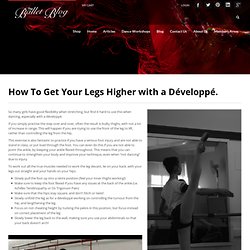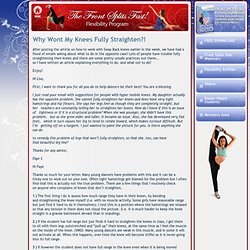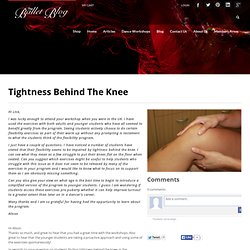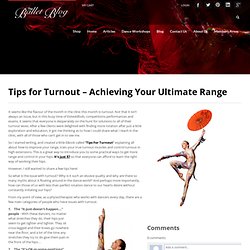

Pointe magazine – Ballet at its Best. Pointe Shoes 101. Carrie Imler of Pacific Northwest Ballet prepping her pointe shoe (Photo courtesy of Bill Mohn)

How To Get Your Legs Higher with a Developpe. So many girls have good flexibility when stretching, but find it hard to use this when dancing, especially with a développé.

If you simply practise the step over and over, often the result is bulky thighs, with not a lot of increase in range. This will happen if you are trying to use the front of the leg to lift, rather than controlling the leg from the hip. Why Wont My Knees Fully Straighten?! After posting the article on how to work with Sway Back knees earlier in the week, we have had a flood of emails asking about what to do in the opposite case!

What To Do With Sway Back Knees…? Tightness Behind The Knee. Hi Lisa, I was lucky enough to attend your workshop when you were in the UK.

I have used the exercises with both adults and younger students who have all seemed to benefit greatly from the program. Training Turnout – Part 1 – Achieving Your Ultimate Range. It seems like the flavour of the month in the clinic this month is turnout.

Not that it isn’t always an issue, but in this busy time of Eisteddfods, competitions performances and exams, it seems that everyone is desperately on the hunt for solutions to all of their turnout woes. After a few clients were delighted with finding more rotation after just a little exploration and education, it got me thinking as to how I could share what I teach in the clinic, with all of those who can’t get in to see me.
So I started writing, and created a little EBook called “Tips For Turnout” explaining all about how to improve your range, train your true turnout muscles and control turnout in high extensions. Pointe magazine – Ballet at its Best. Improve your strength and stamina outside the studio.

When San Francisco Ballet soloist Elizabeth Miner found herself huffing and puffing through David Bintley’s The Dance House, she knew it was time to increase her cross-training. “The piece was nonstop,” says Miner. “Just running it was not enough. I needed to build my aerobic capacity.” In addition to Pilates—which she already did—Miner began using the elliptical trainer for 30 minutes three times a week. Whether it’s running, yoga, spinning classes or weight lifting, non-dance exercise can help improve your technique. A physical therapist or trainer can help you find the regimen that will be most effective for your body. Problem: Low Extensions According to Molnar, strength at the end range of your flexibility is crucial to developing higher extensions.
Don’t leave out the strength of the standing leg. Problem: Low Jumps Stretching correctly is the first step to improving your jumps. Problem: Weak Port De Bras Problem: Lack Of Stamina. Pointe magazine – Ballet at its Best. The Rose Adagio in The Sleeping Beauty is a jewel in a ballerina’s crown: Aurora performs a series of attitude balances and one-handed S promenades with four different partners—without ever coming down from pointe.

Pointe magazine – Ballet at its Best. Improve your jumps with plyometrics.

When it comes to jumping, dancers could learn a thing or two from athletes. While dancers typically practice their jumps by, well, practicing jumps, high jumpers and hurdlers cross-train with exercises called plyometrics. These drills are specifically designed to fine-tune neuromuscular control and build power, speed and agility to help you catch more air time. In a study by the Harkness Center for Dance Injuries at New York University Langone Medical Center, a six-week plyometric training program improved both quadricep and hamstring strength in dancers, and helped them travel farther through space.
To get similar results, work these five plyometric exercises into your routine three days a week. Improve Your Push-Off Strength: Scissor JumpsStarting in parallel, jump and split the legs, with one foot moving front and the other back. Workers in Any Career Would Thrive By Following the Lead of Ballet Dancers, Forbes Says. The Tild Drop with Ashi Ross. 1.

Tendu your right foot forward, then bring it through coupé and up to retiré. 2. Développé your right leg as high as you can, keeping your shoulders lifted. 3. Holding your right leg in the air, release your upper body and head to the left, dropping toward the ground. Dance Magazine – If it's happening in the world of dance, it's happening in Dance Magazine. By Nancy Wozny Three types of stretches to integrate into your regimen Most dancers use more than one kind of stretch to achieve flexibility.
“Using a range gives me the capability to jump higher and to push off of things faster,” says Elizabeth Dement, Liz Gerring Dance Company’s rehearsal director and a dancer with Big Dance Theater. Dynamic, ballistic, and static stretches help the body achieve its full range. Dynamic stretching involves low-impact, dance-like movement; ballistic demands quick and forceful movements; and static holds the body in a fixed position. Hypermobile dancers, however, should approach stretching with care. Dynamic “Do’s” When done before class or rehearsal, dynamic stretching offers an excellent way to increase circulation.